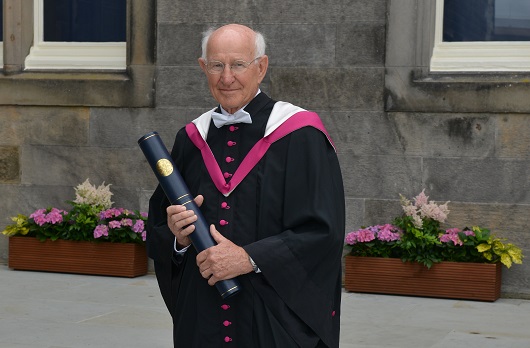Laureation address: Professor Robert Webster

Laureation by Professor Garry Taylor FRSE
Deputy Principal and Master of United College
Chancellor, it is my privilege to present Professor Robert Webster for the degree of Doctor of Science, honoris causa.
The UK’s Risk Register of Civil Emergencies has pandemic influenza as the number one risk. Although the 2009 pandemic turned out not to be as serious as anticipated, the constant emergence of new virus strains and the memory of the 1918 influenza pandemic that caused up to 50 million deaths tells us that we need to remain vigilant. Rob Webster has done more than anyone to help us understand the origins of these new viruses. His work continues to have global impact informing the World Health Organisation and governments on how we can prepare for, and combat, future pandemics.
Rob was one of 13 children brought up on a farm in New Zealand. After taking a BSc and Masters in microbiology at the University of Otago he worked as a virologist for the New Zealand Department of Agriculture for two years before moving to the Australian National University in Canberra for a PhD. It was here that his influenza career of over 50 years started.
There is a famous story of Rob and his Australian colleague Graeme Laver walking along a beach during a family vacation when they came across some dead muttonbirds, or shearwaters. Half jokingly, they wondered if the birds had died of influenza. After unsuccessfully persuading their head of department to fund a trip to the Great Barrier Reef to hunt for bird viruses, they won World Health Organisation funding for the trip. At the reef they found birds that possessed antibodies that could neutralise human viruses and later they discovered that blood from human ‘flu patients contained antibodies that could neutralise avian viruses. This work showed that the influenza virus had found a perfect reservoir in wild birds where it can replicate, mutate and be carried around the globe. While the virus seldom causes disease in wild birds, if passed to another species the consequences can be catastrophic.
In 1968 Rob moved to the remarkable St Jude Children’s Hospital in Memphis, where he remains to this day. Here with his colleague Allan Granhoff he proved experimentally that human and avian influenza viruses could swap their genes in yet another species, the pig, and so the mixing vessel hypothesis was born. Through such genetic reassortment, new influenza viruses continue to emerge from wild birds. The so-called avian H5N1 virus that appeared in 1997 fulfilled Rob’s prophecy about the threat of bird ‘flu. It had its origins in three different viruses from a goose, a teal and a quail. This virus is lethal to domestic poultry and has killed or forced the culling of 400 million birds at a cost of $20 billion. It has also killed 60% of the humans it has infected. In 2013, another virus appeared in Shanghai, denoted H7N9. It has killed over one third of infected humans, and only the culling of poultry in Chinese live bird markets stemmed its spread. Only this month a highly pathogenic H5N2 virus has spread to more than 20 US states and led to the culling of over 45 million poultry. It could take only a few mutations in the viral genes to produce a virus with the ability to spread from human to human and trigger a pandemic. The recent film Contagion contains the line: ‘Someone doesn’t have to weaponise the bird ‘flu; the birds are doing that’.
Rob was one of the first to recognise the constant need to survey the world for new influenza viruses. Always hands on, Rob has sampled countless birds and animals around the globe, most recently in remote areas of Bangladesh where H5N1 is endemic to poultry markets. His lab at St Jude was given WHO designation in 1975 as the only collaborating laboratory on the ecology of influenza viruses in lower animals and birds, and is now part of a US Centre of Excellence in Influenza Research and Surveillance. He was also instrumental in establishing a similar centre at the University of Hong Kong.
Rob has received many honours for his research. He has the rare distinction of being both a Fellow of the UK’s Royal Society and a member of the US National Academy of Sciences. A Centre for Infectious Diseases at the University of Otago has been named after him, and the Robert and Marjorie Webster Chair in Viral Pathogenesis has been established there. The naming of the Chair reflects the key role that Rob’s wife Marjorie has played in his career, and we are delighted that Marjorie joins us here today.
My own research has benefited enormously from collaborations with Rob and others at St Jude, and I had the privilege of attending Rob’s retirement symposium at St Jude earlier this year. Several recurring themes arose during this meeting. First, the extent of his international collaborators, many of whom trained in his lab, and his generosity towards them; second, the extent to which he has promoted women in science; third, the profound impact his research has had on human health, and finally the extent of his published output. Publish, publish, publish is Rob’s mantra. And publish he has: he has just passed 800 publications with 10 papers already this year.
Chancellor, in recognition of his major contribution to the understanding of the origin, ecology and control of the influenza virus I invite you to confer on Professor Robert Webster the degree of Doctor of Science, honoris causa.
Category Awards